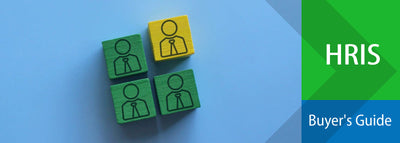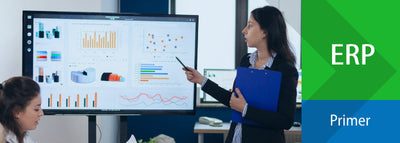How to Choose EAM Software That Actually Works for Your Business (2025 Buyers Guide)
Choosing the right Enterprise Asset Management (EAM) software is a decision that affects far more than your maintenance department. From reducing unplanned downtime to streamlining asset lifecycles, the right system can create a ripple effect of cost savings and efficiency across your entire operation.
Still, many businesses struggle to select a system that aligns with their needs. Some tools promise more than they deliver, while others are so rigid they force teams to adjust workflows just to use the software. The result? Many buyers end up with tools that underdeliver or worse, go unused.
EAM platforms continue to gain traction as organizations aim to get more value out of their physical assets. According to Fortune Business Insights, global spending on enterprise asset management solutions is projected to reach $13.69 billion by 2032, driven by increasing demand for predictive maintenance, IIoT integration, and mobile asset tracking. But with dozens of vendors ranging from niche players to giants like IBM Maximo and SAP EAM, figuring out what really works for your team is more important than ever.

In this guide, we’ll walk through the essentials of choosing EAM software in 2025. Whether you're moving off spreadsheets or upgrading from a legacy CMMS, we’ll cover what to look for, what to avoid, and how to choose a platform that aligns with your goals, processes, and asset complexity.
What Is EAM Software and Who Really Needs It?
Enterprise Asset Management (EAM) software helps organizations take control of their physical assets—things like machinery, vehicles, buildings, and infrastructure. It’s all about making sure these assets stay in good shape, run efficiently, and last as long as possible. That means less downtime, fewer surprise repairs, and better planning across the board.
But EAM goes beyond just maintenance tracking. Today’s systems often include tools for preventive maintenance, work orders, inventory management, procurement, compliance, and even mobile apps for teams out in the field. The goal? Give your maintenance and operations teams one central place to manage everything and make smarter, faster decisions.
So who actually uses EAM software? Quite a few industries. It’s especially popular in manufacturing, energy, utilities, healthcare, and government. In fact, manufacturing led the pack in 2024, making up 27.5% of the global EAM market by end-user, according to Fortune Business Insights.

Who Needs EAM Software?
EAM tools are most often used in asset-intensive industries where uptime, safety, and performance are mission-critical. This includes:
- Manufacturing – managing equipment, tools, and production lines to prevent costly outages.
- Utilities & Energy – maintaining grid infrastructure, substations, and remote assets in real time.
- Transportation & Logistics – tracking fleet maintenance, warehouse equipment, and loading systems.
- Facilities Management – overseeing HVAC systems, lighting, and building compliance across sites.
- Public Sector & Government – handling infrastructure like water systems, roads, and public buildings.
Even smaller organizations with fewer assets can benefit from EAM software if asset reliability, maintenance costs, or regulatory compliance are consistent concerns.
Ultimately, if your business relies heavily on physical assets and you’re still managing them with spreadsheets, outdated tools, or disconnected systems, adopting the right EAM software can make a measurable difference in both performance and cost control.
Key Features to Look for in EAM Software

Choosing the right EAM software isn’t just about ticking boxes, it’s about finding a system that fits how your teams actually work. The best enterprise asset management systems go beyond the basics to support smarter, more proactive maintenance operations. Here are the capabilities that set effective EAM tools apart from those that gather dust after implementation.
1. Asset Lifecycle Management
A strong EAM platform should track assets from acquisition to disposal. That includes everything from purchase details and warranty coverage to usage logs, inspections, condition scores, and end-of-life planning. With a complete lifecycle view, you can optimize capital investments, extend asset longevity, and avoid costly surprises.
2. Preventive Maintenance Scheduling
Shifting from reactive to preventive maintenance is one of the fastest ways to improve uptime and reduce emergency repair costs. Look for systems that can automate maintenance schedules based on usage metrics, meter readings, time intervals, or real-time condition data. Some tools also support predictive triggers by analyzing data from sensors or connected equipment.
3. Work Order Management
A good EAM system streamlines the entire work order process, from request and approval to assignment, execution, and documentation. Templates, mobile capabilities, time tracking, and support for images and digital checklists help ensure that no task falls through the cracks. This not only boosts technician productivity but also creates a detailed audit trail for compliance and reporting.
4. Spare Parts & Inventory Control
Missing parts can delay repairs, while excess inventory ties up capital. Robust inventory features let you monitor stock levels across multiple sites, track part usage, and trigger reorders automatically when thresholds are met. Some solutions also integrate with procurement systems to centralize vendor orders and pricing.
5. Mobile Access for Field Teams
Maintenance isn’t done at a desk. Whether your team is working in a warehouse, on a production floor, or at a remote site, mobile functionality is essential. Technicians should be able to log hours, update work orders, capture photos, and access manuals on the go even when offline. The result? Faster resolution times and better data accuracy.
6. System Integrations
EAM software should integrate seamlessly with your existing stack. That includes ERP systems for financial alignment, procurement tools for vendor management, IoT platforms for sensor data, and even HR systems for technician scheduling. Tight integrations reduce manual entry, eliminate siloed data, and support a more connected operation.
7. Reporting & Analytics
To improve what you manage, you need to measure it. Strong reporting tools allow teams to track key metrics like mean time to repair (MTTR), asset downtime, and maintenance costs. More advanced EAM platforms include custom dashboards, benchmarking tools, and predictive analytics that help teams move from reactive firefighting to data-driven planning.
8. GIS & Asset Mapping
Organizations managing field assets like municipalities, utilities, and transportation networks benefit from geographic information system (GIS) integration. With asset mapping, teams can view service locations on a map, optimize routing, and identify location-based failure trends. It’s a major advantage when managing infrastructure that spans wide areas.
9. Compliance & Audit Trails
For industries with strict regulations, like energy or manufacturing, EAM tools should support audit readiness. That means complete maintenance histories, automated logs, documentation links, and the ability to generate reports for inspectors or compliance officers without digging through spreadsheets.
10. Multi-Site and Role-Based Access
If your organization operates across multiple facilities or business units, look for a solution that supports role-based permissions and site-specific data views. This allows for centralized oversight without sacrificing operational independence at the local level.
How to Evaluate Vendors (and Avoid Common Mistakes)

Once you’ve defined what your business needs from an EAM system, it’s time to look at vendors but not all solutions are created equal. Between flashy demos, long feature lists, and aggressive sales tactics, it’s easy to get overwhelmed. Here’s how to evaluate EAM software providers more effectively and avoid the common mistakes buyers make along the way.
Start with Your Use Cases, Not Their Feature Sheet
Rather than starting with what the vendor offers, anchor your evaluation in what your teams actually need to do, especially the day-to-day workflows of your maintenance and operations teams. Bring real scenarios to the table, such as "how we handle emergency repairs at multiple facilities" or "how we currently manage spare parts replenishment." A good vendor should be able to walk you through how their platform solves those problems in practice.
Ask About Implementation and Support Up Front
Many EAM projects fail not because of the software, but because the implementation is rushed or unsupported. Ask potential vendors about average deployment timelines, onboarding processes, and the level of support offered post-sale. Will you have a dedicated account manager? Is training included? Are updates seamless or disruptive? Vendors with a track record of customer success will have clear answers here.
Check for Hidden Costs
Licensing models for EAM platforms vary widely. Some vendors offer transparent per-user pricing; others charge extra for modules like mobile access, GIS integration, or advanced analytics. Be sure to get a full breakdown of costs, license fees, implementation, data migration, training, support, and ongoing maintenance before committing. Don’t just ask what it costs today; ask how much it will cost to scale.
Verify Integration Capabilities
Most organizations don’t want to rip and replace their entire tech stack. That’s why integration with existing systems ERP, procurement, accounting, and IoT is essential. Ask for specific examples of integrations that are already live with systems like SAP, Oracle, Microsoft Dynamics, or your current CMMS tools. If possible, speak with a reference customer who uses similar integrations.
Evaluate the User Experience (UX)
An EAM system is only as useful as your team's willingness to use it. Complex interfaces and unintuitive workflows lead to low adoption. During demos, bring in the people who’ll actually use the tool, maintenance supervisors, field techs, and asset managers and let them test the experience for themselves. Pay attention to how many clicks it takes to complete common tasks like logging a repair or checking an asset’s maintenance history.
Ask for Industry-Specific Experience
Some EAM systems are built with manufacturing in mind, while others serve utilities, transportation, or facilities management. Choosing a vendor with experience in your industry can significantly reduce implementation risks and ensure better out-of-the-box configurations. Ask for case studies or references in your field.
Look Beyond the Demo
Demos are helpful, but they’re also highly controlled environments. Ask for access to a trial environment or sandbox to explore the platform yourself. Or better yet, request a proof of concept (POC) based on your own data or workflows. Vendors who are confident in their fit will be happy to prove it.
Beware of Overpromising
If a vendor says “yes” to everything without nuance or explanation, that’s a red flag. A trustworthy provider will tell you what their system can’t do or where customization may be needed. Overpromising leads to scope creep, missed expectations, and buyer’s remorse.
Ways to Reduce Cost Without Sacrificing Capabilities
Enterprise Asset Management software doesn’t need to strain your budget especially if you take a thoughtful, phased approach to buying. Below are cost-saving strategies that help you stay within budget while still getting the features and functionality that matter most.
1. Prioritize the Features That Actually Drive ROI
Every EAM system offers dozens of capabilities but not all of them are essential from day one. Predictive analytics, IoT, and AI-driven recommendations may sound appealing, but they won’t deliver value if you’re still struggling to manage preventive maintenance or track inventory.
What to do:
Focus on high-impact core features like:
-
Preventive maintenance scheduling
-
Work order management
-
Asset tracking and reporting
-
Spare parts and inventory control
Use a requirements checklist to map vendor capabilities to your actual business needs. This helps avoid scope creep and keeps demos focused on practical use cases.
2. Pick the Right Deployment Model
The way your system is hosted can significantly affect total cost. Cloud-based (SaaS) models tend to offer lower upfront costs and simpler upgrades, while on-premise deployments may require more up-front investment but provide more control over data and infrastructure.
|
Deployment Model |
Upfront Cost |
Ongoing Maintenance |
Best For |
|
Cloud (SaaS) |
Low |
Included in subscription |
Most mid-sized to large organizations |
|
On-Premise |
High |
Paid separately by internal IT |
Regulated industries or companies with strict data requirements |
Choose the option that matches your internal IT capabilities and regulatory environment.
3. Don’t Overbuy User Licenses
EAM vendors often structure pricing by user type admin, technician, viewer, etc. and it’s easy to overspend if you assume everyone needs a full license. For example, field techs may only require mobile access for completing work orders.
What to do:
Clarify how license types are defined and ask if limited or read-only roles are available. Push for flexible pricing that scales as your team grows.
4. Negotiate Tiered Pricing or Volume Discounts
If you plan to roll the system out across multiple locations or over time, ask vendors for phased pricing or volume-based discounts. Multi-year contracts or bundled modules can often lead to cost savings just make sure the contract includes performance guarantees and flexible upgrade options.
5. Implement in Phases
You don’t need to deploy everything at once. Rolling out modules in phases starting with critical ones like maintenance and inventory helps control costs and gives teams time to adopt the system properly.
Start with:
-
Preventive maintenance
-
Work order management
-
Basic asset tracking
Expand into:
-
Advanced analytics
-
IoT integrations
-
GIS or mobile extensions
6. Review Vendor Support Models Carefully
Support packages can vary significantly in both cost and coverage. Some vendors charge extra for 24/7 support, dedicated success managers, or on-site training.
What to do:
Get a clear breakdown of what’s included in each support tier. Match support levels to your internal capabilities if you have an in-house IT team, a lower-tier plan might be enough.
7. Take Advantage of Pilots and Trials
Many vendors offer sandbox environments, pilot programs, or 30-day trials. These can be valuable for testing workflows, evaluating ease of use, and confirming system compatibility before making a long-term investment.
Pro tip:
Use real data and actual maintenance scenarios during the trial to see how well the system fits your day-to-day operations.
Common Mistakes to Avoid When Buying EAM Software

Selecting an enterprise asset management system is a high-stakes decision. A poor fit can lead to project delays, frustrated teams, and underused software. Below are some of the most common and expensive mistakes buyers make, along with guidance on how to avoid them.
1. Failing to Define Business Goals Early
Many organizations jump into the vendor search without a clear understanding of what they actually need the system to solve. This leads to "feature chasing" getting distracted by bells and whistles rather than focusing on strategic alignment.
What to do instead:
Start with a needs assessment. Identify pain points in your current process whether it's unplanned downtime, poor visibility into asset health, or compliance issues. Translate these into specific objectives your EAM system should support (e.g., reduce emergency maintenance by 30% in 12 months). These goals should drive your requirements, not the other way around.
2. Choosing Software Based on Price Alone
A common trap is to pick the cheapest software or the vendor offering the deepest discount. But initial license fees don’t reflect the true cost of ownership. Implementation, training, integrations, customizations, and ongoing support often add up quickly and some vendors charge separately for all of it.
What to do instead:
Ask for a 3- to 5-year total cost of ownership (TCO) estimate. This should include:
-
User licenses (initial + ongoing)
-
Implementation and configuration services
-
Data migration and integrations
-
Training and onboarding
-
Annual support and upgrade fees
Cheaper isn’t always better especially if functionality or long-term support is lacking.
3. Not Involving End Users in the Selection Process
It’s easy to evaluate a system from a management or IT perspective and forget about the people who will use it every day: technicians, planners, warehouse teams. If the interface is clunky or doesn't reflect how they work, adoption will suffer.
What to do instead:
Involve end users in demos and pilot testing. Ask vendors to walk through real-world scenarios like logging a fault from the field or checking inventory levels from a mobile device. Systems that support the daily rhythm of your team will generate value much faster.
4. Underestimating Implementation Complexity
EAM deployments aren't plug-and-play. Data must be cleaned and structured, workflows customized, integrations tested, and teams trained. Rushing this process often results in broken processes or a system nobody trusts.
What to do instead:
Build a phased implementation plan. Focus first on high-impact use cases (e.g., preventive maintenance or asset tracking), then expand into areas like analytics or IoT. Assign internal champions and allocate time for testing and feedback before full rollout.
5. Overlooking Integration and Scalability
EAM software should not be a silo. If it doesn't integrate with your ERP, finance tools, or procurement systems, your team will waste time duplicating data or building workarounds. Worse, it may limit your ability to scale.
What to do instead:
Ask vendors about pre-built integrations and API support. Will it connect with your existing tech stack? Can it scale to support more sites, teams, or assets as you grow?
6. Choosing a Vendor That Doesn’t Understand Your Industry
Some EAM platforms are built with specific industries in mind like utilities, transit, or manufacturing. Others are more generic and require heavy customization. If your vendor doesn’t speak your language, they may struggle to support critical needs like compliance, regulatory reporting, or industry-standard KPIs.
What to do instead:
Ask for case studies or references from organizations in your industry. Look for vendors who understand your asset types, maintenance models, and reporting needs without requiring you to build everything from scratch.
Top Questions to Ask EAM Vendors Before You Buy
Choosing the right EAM software isn’t just about checking feature boxes it’s about making sure the system fits your workflows, integrates well, and won’t hit you with hidden costs after you’ve signed the contract. These questions will help you dig beneath the surface during vendor demos and proposal reviews.
1. How is your pricing structured?
-
Is pricing based on named users, concurrent users, or role-based tiers?
-
What’s included in the base price, and what’s considered an add-on?
-
Are there discounts for long-term contracts or multi-site rollouts?
2. What does implementation typically look like for companies like ours?
-
How long does it take to go live?
-
What services are included training, data migration, configuration?
-
What’s your approach to change management?
3. Can your system integrate with our existing platforms?
-
Do you support out-of-the-box integrations with ERP, procurement, or sensor systems?
-
What tools or APIs are available for custom integrations?
-
Are integrations included in the base price or sold separately?
4. How does your software handle mobile access and offline mode?
-
Is there a native mobile app? Does it work offline?
-
What tasks can technicians perform from the field?
-
Are mobile licenses priced differently?
5. What kind of support do you offer, and what does it cost?
-
Is support 24/7 or business hours only?
-
Do we get a dedicated account rep or success manager?
-
What are response times and SLAs for support tickets?
6. How customizable is the platform?
-
Can we configure forms, fields, workflows, or dashboards without a developer?
-
Are customizations upgrade-safe?
-
Do you charge extra for changes post-implementation?
7. What reporting and analytics tools are available?
-
Can we create custom dashboards and export reports?
-
Do you offer KPI tracking, asset performance insights, or predictive analytics?
-
How easy is it to extract insights for audits or board-level reporting?
8. What’s your product roadmap?
-
Are there upcoming features we should know about?
-
How often do you release updates?
-
Do customers influence product development?
9. Can you provide references from customers in our industry?
-
Especially those with similar asset types, regulations, or geographic spread.
-
What challenges did they face during implementation, and how were they resolved?
10. Do you offer a free trial or pilot program?
-
Can we test the software with real data or workflows?
-
Is the pilot configured to match our actual use case?
-
Will your team support us during the trial?
Choosing the Right EAM Solution for Your Business
Enterprise Asset Management software isn’t a one-size-fits-all decision. The right solution depends on your industry, asset types, team structure, and long-term goals. Instead of chasing the most feature-rich system, focus on fit functionality, usability, and alignment with your current and future needs.
Here’s how to narrow your options with confidence:
1. Start with a Clear Requirements List
Before jumping into demos, build a clear list of your must-have features and workflows. This will help you filter out solutions that look great on paper but don’t address your real problems. Prioritize functions like preventive maintenance, work order automation, mobile access, or regulatory compliance whatever keeps your operations running.
2. Involve the Right Stakeholders
Include input from maintenance leads, IT, finance, and end users. Maintenance teams can flag usability issues, IT can assess integration needs, and finance can validate the total cost of ownership. Cross-functional input helps you avoid selecting a tool that ends up being underused.
3. Look for Configurability, Not Just Customization
Highly configurable systems allow you to tailor fields, workflows, and dashboards to your business without needing to pay for custom development. That flexibility becomes critical as your needs evolve over time.
4. Evaluate Vendor Strength and Support
A strong vendor isn’t just selling software, they're a long-term partner. Consider their implementation track record, customer success team, and update cadence. Ask how often they release new features, and whether support is included or billed separately.
5. Request a Tailored Demo
Generic demos can make any software look impressive. Ask vendors to walk through scenarios based on your assets, teams, and industry. This helps you see whether the tool will actually work the way you need it to.
6. Compare Total Cost of Ownership
Don’t base your decision on license fees alone. Compare all-in costs: implementation, training, integrations, optional modules, and ongoing support. A cheaper system up front can cost more in the long run if it’s hard to use or requires constant vendor intervention.
7. Think Beyond Today’s Needs
Finally, choose a system that can grow with you. Can it support multiple locations? Does it scale across asset types? Does it offer advanced features (like IoT or analytics) that you may want down the line? Even if you don’t need them now, it’s useful to have the option without switching platforms.
Important Resources to Consider
Selecting and implementing EAM software involves more than just product comparison, it requires informed decision-making backed by expert insights and hands-on tools. Below are some resources worth reviewing as you move forward:
-
Best Asset Tracking Software BattleCard 2025 – HXGN EAM vs. eMaint vs. Maximo
- Best EAM Software BattleCard 2025 – IBM Maximo vs. SAP EAM vs. Oracle EAM
-
Top CMMS Software BattleCard 2025 – Champs vs. Eptura Asset vs. eMaint
- Top 30 EAM Software Comparison BattleCard 2025
- CMMS/EAM Software Pricing & Features Comparison Report






